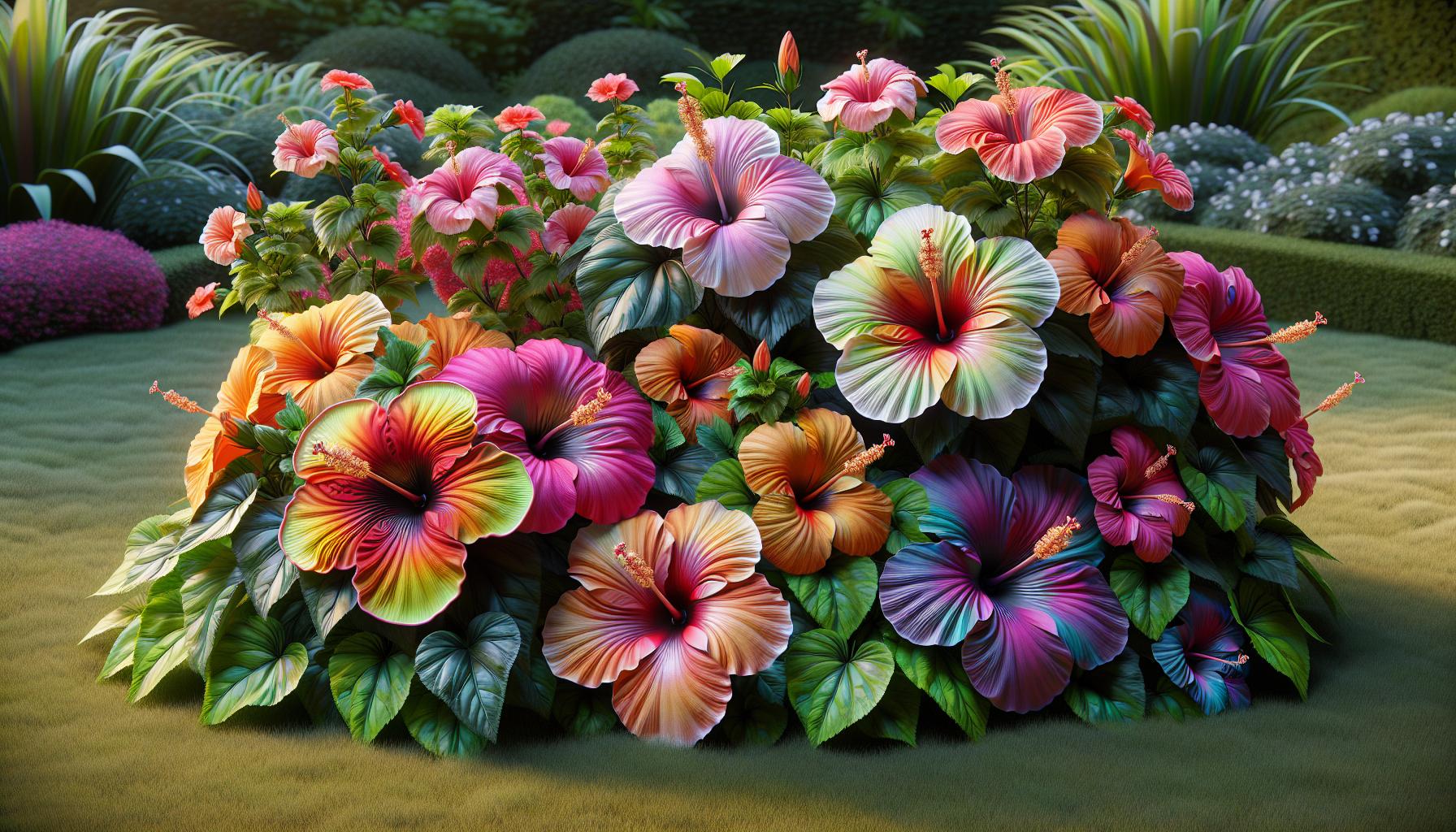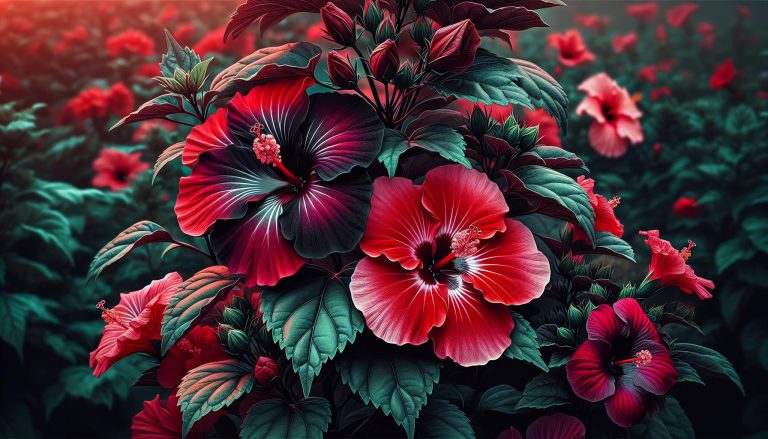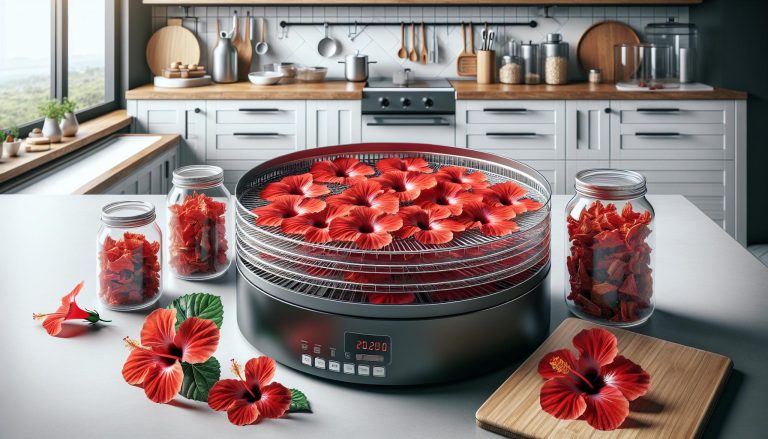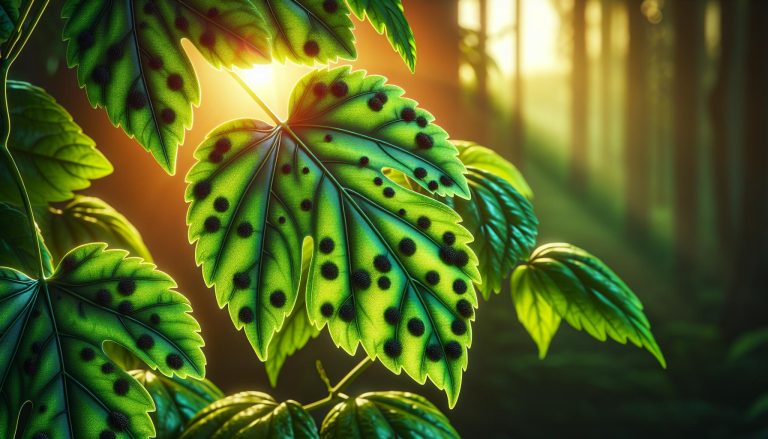Identify Your Hibiscus: Hardy or Tropical? Essential Guide
In the world of vibrant blooms and lush foliage, hibiscus plants hold a special place in our hearts. Whether adorning our gardens or brightening our homes, these flowers bring a touch of the tropics wherever they grow. But not all hibiscus plants are created equal. There’s a crucial difference that often puzzles gardeners: how can we tell if our hibiscus is hardy or tropical?
Understanding this distinction is essential for providing the right care and ensuring our plants thrive in their environment. We’re here to guide you through the key features and tips that make it easy to distinguish between hardy and tropical hibiscus. From leaf shape to blooming patterns, we’ll help you decode the secrets of your hibiscus, ensuring it blossoms to its full potential. Let’s dive into the world of hibiscus together and discover how to identify your plant’s true nature.
Key Takeaways
- Understand the Distinction Between Hardy and Tropical Hibiscus: Recognizing the differences in leaf texture, flower size, and climate tolerance between hardy (suitable for cooler climates and known for their large blooms and heart-shaped leaves) and tropical hibiscus (thriving in warm conditions with glossy, colorful blooms) is crucial for appropriate care and flowering.
- Tailored Care Based on Type: Hardy hibiscus requires well-drained soil, full to partial sunlight, and minimal winter care, thriving in USDA zones 4-9. In contrast, tropical hibiscus needs consistent warmth, frequent watering, full sunlight, and winter protection indoors or in a greenhouse, suitable for USDA zones 9-11.
- Pruning and Maintenance Strategies Differ: Autumn pruning benefits hardy hibiscus, helping in vigorous spring growth, while tropical hibiscus benefits from spring pruning for shape and to remove frost damage, requiring year-round attention due to its continuous growth in warmer climates.
- Winter Care Is Key: Winterization methods vary significantly; hardy hibiscus can survive outdoor winters with mulch protection in suitable zones, whereas tropical hibiscus must be brought indoors to avoid freeze damage, requiring light and reduced watering.
- Avoid Common Mistakes in Identification: Don’t rely solely on flower color for identification. Instead, pay close attention to leaf shape, texture, and plant growth habits, as well as bloom size and the plant’s overall size and structure, to accurately determine whether your hibiscus is hardy or tropical.
- Location and Climate Considerations Are Fundamental: Selecting a hibiscus that suits your climate and understanding its specific needs ensures its health and vibrancy, contributing to a flourishing garden or indoor space.
Understanding Hibiscus Varieties
After discussing the importance of distinguishing between hardy and tropical hibiscus plants for their proper care, we delve deeper into understanding these two main varieties. Knowing whether a hibiscus plant is hardy or tropical is crucial for its survival and blooming. Each type has specific characteristics that cater to different gardening needs and climates.
Hardy Hibiscus
Hardy hibiscus, often celebrated for its resilience, can survive in colder climates, enduring temperatures well below freezing. These plants usually die back to the ground in winter and regrow in spring, showcasing their ability to withstand harsher conditions. The leaves of hardy hibiscus are typically heart-shaped with a matte texture, revealing a sturdy nature adapted to various outdoor environments. Blooms from hardy hibiscus are diverse in color, ranging from white to deep reds, and impress with their size, sometimes reaching up to 12 inches in diameter. Gardeners appreciate hardy hibiscus for its late summer to early fall blooming period, providing color and vibrancy when most other plants start to fade.
Tropical Hibiscus
In contrast, tropical hibiscus thrives in warmer climates and does not tolerate freezing temperatures. This variety demands a consistently warm environment to flourish, making it ideal for indoor gardening or regions with mild winters. The glossy leaves of tropical hibiscus plants are a telltale sign of their need for humidity and warmth, reflecting more light than their hardy counterparts. These plants often feature smaller but more brightly colored and varied blooms, including shades of orange, yellow, pink, and multicolor patterns. Notably, tropical hibiscus plants can bloom year-round if their environmental needs are met, offering continuous beauty to your garden or home.
Each hibiscus variety brings its unique beauty and requires specific care. Understanding these differences ensures gardeners can provide the optimal conditions for their plants, whether they have a hardy variety suited for outdoor gardens in cooler regions or a tropical variety that enlivens indoor spaces or warm climates.
Key Characteristics to Differentiate Hardy and Tropical Hibiscus

Building on our understanding of the distinct needs and appearances of hardy and tropical hibiscus plants, it’s crucial to pinpoint specific characteristics to accurately identify each type. These differences not only aid in proper care but also ensure that gardeners can enjoy the unique aesthetics of these plants to the fullest. Let’s delve into the key features that distinguish hardy from tropical hibiscus, focusing on leaf shape and texture, flower size and color, and growth habits and size.
Leaf Shape and Texture
Observing the leaves offers a clear starting point in distinguishing between hardy and tropical hibiscus plants. Hardy hibiscus leaves are typically heart-shaped with a matte finish, providing a subtle, understated backdrop to their showy blooms. This textural quality helps endure the varying temperatures of cooler climates. In contrast, tropical hibiscus leaves boast a glossy sheen, reflecting their tropical origins and preference for bright, direct sunlight. These leaves are often more lance-shaped, adding to the plant’s exotic appearance and helping it thrive in warm environments.
Flower Size and Color
The flowers of hardy and tropical hibiscus plants present vivid distinctions in size and color, which are key indicators of each plant’s variety. Hardy hibiscus blooms are notable for their impressive size, often reaching up to 12 inches in diameter, and come in a range of colors including white, pink, red, and even bi-colored varieties. Their size and late blooming period from late summer to early fall make them standouts in the garden. Conversely, tropical hibiscus flowers are smaller, typically 4 to 6 inches in diameter, but make up for size with a broad palette of bright, tropical colors such as yellow, orange, coral, and deep red. Tropical hibiscus can bloom year-round under optimal conditions, bringing continuous color to suitable environments.
Growth Habits and Size
Finally, understanding the growth habits and size of hardy versus tropical hibiscus plants can provide further clarity. Hardy hibiscus is known for its robust growth, capable of reaching heights of up to 7 feet in optimal conditions, with a spread that can fully occupy garden beds. This makes them ideal for adding height and volume to outdoor spaces. Tropical hibiscus, on the other hand, tends to be more compact, generally reaching up to 4-5 feet when grown outdoors and even smaller when kept indoors, which suits it well for pots and smaller garden spaces. Its growth habit is bushier, making it a favorite for creating lush, tropical landscapes or as vibrant houseplants.
By noting these key characteristics – leaf shape and texture, flower size and color, and growth habits and size – gardeners can reliably identify hardy and tropical hibiscus plants. This knowledge ensures appropriate care, enabling these stunning plants to flourish whether they’re adding a tropical touch to a warm, sunny spot or bringing late-season color to cooler climates.
Seasonal Care Requirements

Building on our understanding of the distinctive features between hardy and tropical hibiscus plants, it’s crucial to delve into the specific seasonal care requirements that ensure their thriving. Each variety demands a tailored approach to water, sunlight, and pruning, given their unique environmental preferences and growth habits. Here, we break down the essential care tips for both hardy and tropical hibiscus to cultivate healthy, vibrant plants year-round.
Hardy Hibiscus Care
Hardy hibiscus plants, accustomed to enduring colder climates, exhibit a remarkable resilience that dictates their care regimen. Throughout the growing season, from late spring to early fall, consistent watering facilitates robust growth, especially during dry spells. However, it’s vital to ensure well-drained soil to prevent root rot, a common issue in overly saturated conditions.
Sunlight plays a critical role in the health of hardy hibiscus, with a preference for full sun to partial shade. At least six hours of direct sunlight daily encourages prolific blooming. When it comes to fertilization, a balanced, slow-release fertilizer applied in early spring and midsummer supports their nutritional needs without overwhelming the plant.
As winter approaches, hardy hibiscus requires minimal maintenance. In regions experiencing frost, the plants die back to the ground and remain dormant until the warmth of spring triggers new growth. Protecting the base with mulch ensures a protective layer against the cold, enriching the soil as it decomposes.
Tropical Hibiscus Care
In contrast, tropical hibiscus plants thrive in warm, humid environments, necessitating a different set of care instructions to flourish. They demand frequent, thorough watering to maintain consistently moist soil, reflecting their natural tropical habitat. Yet, like their hardy counterparts, ensuring proper drainage is key to averting root diseases.
Tropical hibiscus plants crave sunlight, requiring full sun exposure for six to eight hours a day to produce vibrant, colorful blooms. During the peak summer months, some afternoon shade can prevent leaf scorch, particularly in hotter climates.
Fertilization plays a crucial role in the growth and flowering of tropical hibiscus. Utilizing a high-potassium fertilizer every two weeks during the growing season boosts bloom production and enhances plant vigor. As winter sets in, reducing fertilizer application supports a natural period of rest, especially for plants kept indoors.
Winter care for tropical hibiscus involves protection from cold temperatures. Ideally, these plants are brought indoors or to a greenhouse where temperatures stay above 50°F (10°C). Maintaining humidity levels and providing adequate light during this time ensures the plant survives until warmer temperatures allow for outdoor reintroduction.
Location and Climate Considerations

Building on our understanding of the distinct requirements for hardy and tropical hibiscus plants, let’s delve into how location and climate play a pivotal role in distinguishing and caring for these varieties. Recognizing the ideal conditions for each type ensures we provide the right environment for our hibiscus to thrive.
Ideal Conditions for Hardy Hibiscus
Hardy hibiscus plants excel in a variety of climates, particularly thriving in USDA zones 4 through 9. These resilient varieties can survive freezing temperatures, making them a perfect addition to gardens in cooler regions. Here’s what they need:
- Temperature Tolerance: Hardy hibiscus plants can withstand winter temperatures as low as -30°F. Despite their robust nature, they appreciate the warmth of spring and summer to bloom profusely.
- Sunlight Exposure: They require full to partial sunlight, with a preference for at least six hours of direct sunlight daily to ensure optimal growth and flowering.
- Soil Requirements: Well-drained soil is crucial, with a preference for slightly acidic to neutral pH levels, between 6.0 and 7.0.
- Watering Needs: Although they are drought-tolerant once established, consistent watering during their growing season promotes healthier blooms.
By meeting these conditions, hardy hibiscus plants will reward us with their stunning, large flowers and robust growth, ensuring a lively addition to our gardens.
Ideal Conditions for Tropical Hibiscus
Tropical hibiscus plants, in contrast, prefer warmer climates and are best suited to USDA zones 9 to 11. Their need for consistent warmth and protection from cold weather defines their care. Here are their requirements:
- Temperature Requirements: Tropical hibiscus plants thrive in temperatures above 50°F and need protection from frost. Temperatures below 50°F can cause damage or slow growth.
- Sunlight Needs: Full sunlight is ideal, requiring at least six to eight hours of direct light daily to flourish and produce vibrant flowers.
- Soil Preferences: They favor well-draining, rich soil, with a slightly acidic to neutral pH, ideally between 6.5 and 7.5.
- Watering and Fertilization: Frequent watering and high-potassium fertilizer encourage lush foliage and continuous blooming in tropical hibiscus plants.
Adapting our garden care to suit these tropical beauties’ needs, especially in colder climates, often means bringing them indoors during winter. Providing ample sunlight, warmth, and humidity indoors mimics their natural habitat, ensuring they continue to thrive regardless of outdoor conditions.
We understand the importance of selecting the right hibiscus type for our garden’s climate and location. By catering to each variety’s specific needs, we ensure our hibiscus plants maintain their health and vibrancy, offering a dazzling display of colors throughout their blooming seasons.
Common Mistakes in Identifying Hibiscus Types

When attempting to distinguish between hardy and tropical hibiscus plants, gardeners often encounter several common mistakes. Misinterpreting flower color and overlooking leaf differences can lead to incorrect identification, impacting the appropriate care and climate considerations necessary for the plant’s health and bloom production. In this section, we’ll explore these two critical areas of confusion to enhance our understanding of how to accurately identify hibiscus types.
Misinterpreting Flower Color
One prevalent mistake in identifying hibiscus types is misinterpreting the significance of flower color. Given the wide variety of vibrant hues both hardy and tropical hibiscus flowers display, it’s easy to assume that specific colors are exclusive to each type. However, both varieties boast an array of colors from whites and pinks to reds and yellows. The mistake lies in overlooking the fact that flower color is not a reliable indicator of a hibiscus plant’s variety. Instead, the focus should be on other characteristics such as bloom size and structure. While tropical hibiscus flowers have a glossy appearance and can bloom year-round in the right conditions, hardy hibiscus blooms are larger, boasting a more papery texture, and typically flower from late spring to early fall. Relying solely on flower color can lead to confusion and improper care practices.
Overlooking Leaf Differences
Another common mistake is overlooking the key differences in leaf characteristics between hardy and tropical hibiscus plants. Leaf shape, size, and texture offer significant clues to accurately identifying the hibiscus variety. Hardy hibiscus plants generally have heart-shaped, slightly glossy leaves with a fine texture, while tropical hibiscus leaves are dark green, glossy, and often have a leathery feel. Furthermore, the leaf arrangement and overall plant structure provide additional hints; hardy hibiscus plants tend to have a more open, shrubby appearance, contrasting with the denser, bushier growth habit of tropical varieties. Ignoring these distinctions can mislead gardeners, affecting the plant’s proper placement and care in the garden. Recognizing the subtleties in leaf characteristics plays a crucial role in distinguishing between hardy and tropical hibiscus, ensuring they receive the appropriate care for their specific needs.
How to Care for Your Hibiscus Based on Its Type

Transitioning seamlessly from the identification process, we delve into the tailored care routines requisite for nurturing the two types of hibiscus plants: hardy and tropical. Recognizing their distinct needs is pivotal for their thriving, reflecting the importance of their accurate distinction discussed earlier.
Pruning and Maintenance
Pruning and ongoing maintenance practices differ notably between hardy and tropical hibiscus. Hardy hibiscus, accustomed to enduring colder climates, benefit from autumnal pruning. Trimming them back in late fall, after they’ve gone dormant, encourages healthier, more robust growth in spring. For these plants, removing dead stems and spent flowers aids in preventing disease and pest infestation.
Conversely, tropical hibiscus requires more frequent attention throughout the year, given their continual growth in warmer climates. These varieties thrive with regular pruning to shape the plant and encourage bushier growth. Spring emerges as the ideal time for a significant trim, ensuring removal of any frost-damaged parts and shaping the plant for the upcoming growth period.
Winterizing Your Hibiscus
The approach to winterizing hibiscus plants underscores the stark distinctions between hardy and tropical varieties. Hardy hibiscus, true to their name, exhibit resilience against colder temperatures. They can withstand winter in the ground in most climates where they’re hardiness is matched. Mulching around the base with straw or shredded bark helps insulate the roots, providing an added layer of protection against freezing temperatures.
Tropical hibiscus, on the other hand, cannot survive freezing temperatures and require indoor shelter during colder months in non-tropical zones. Before the first frost, it’s crucial to bring these plants indoors, ensuring they’re placed in a well-lit area, away from direct heat sources. This transition demands acclimation to indoor conditions, with reduced watering and cease fertilization until they return outdoors in spring.
Our discussion on hibiscus care, steeped in the importance of distinguishing between hardy and tropical varieties, illuminates the customized approaches essential for their health and vibrancy. Pruning, maintenance, and particularly winterizing strategies are tailored to each type, reinforcing the significance of correct identification for optimal care. By adhering to these guidelines, enthusiasts can ensure their hibiscus plants flourish, reflecting beauty and resilience in their gardens.
Conclusion
We’ve explored the crucial differences between hardy and tropical hibiscus plants, shedding light on the importance of distinguishing between them for proper care. Recognizing the unique characteristics of each variety ensures that we’re providing the right environment, from pruning techniques to winterizing strategies. By tailoring our care routines to meet the specific needs of hardy and tropical hibiscus, we can enjoy the beauty and vibrancy of these plants in our gardens. Let’s embrace the diversity of the hibiscus family by applying our newfound knowledge to cultivate thriving plants that reflect their natural splendor.







